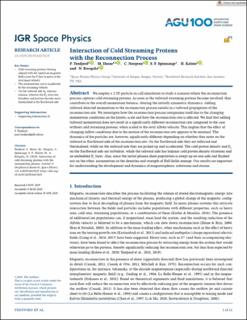Interaction of Cold Streaming Protons with the Reconnection Process
Tenfjord, Paul; Hesse, Michael; Norgren, Astrid Elisabet Cecilia; Spinnangr, Susanne Flø; Kolstø, Håkon Midthun; Kwagala, Norah Kaggwa
Journal article, Peer reviewed
Published version

Åpne
Permanent lenke
https://hdl.handle.net/11250/2763339Utgivelsesdato
2020Metadata
Vis full innførselSamlinger
- Department of Physics and Technology [2161]
- Registrations from Cristin [10402]
Originalversjon
Journal of Geophysical Research: Space Physics. 2020, 125 (6), e2019JA027619. 10.1029/2019JA027619Sammendrag
We employ a 2.5D particle-in-cell simulation to study a scenario where the reconnection process captures cold streaming protons. As soon as the tailward streaming protons become involved, they contribute to the overall momentum balance, altering the initially symmetric dynamics. Adding tailward-directed momentum to the reconnection process results in a tailward propagation of the reconnection site. We investigate how the reconnection process reorganizes itself due to the changing momentum conditions on the kinetic scale and how the reconnection rate is affected. We find that adding tailward momentum does not result in a significantly different reconnection rate compared to the case without cold streaming protons, when scaled to the total Alfvén velocity. This implies that the effect of changing inflow conditions due to the motion of the reconnection site appears to be minimal. The dynamics of the particles are, however, significantly different depending on whether they enter on the tailward or Earthward side of the reconnection site. On the Earthward side they are reflected and thermalized, while on the tailward side they are picked up and accelerated. The cold proton density and Ez on the Earthward side are turbulent, while the tailward side has laminar cold proton density striations and an embedded Ez layer. Also, since the initial plasma sheet population is swept up on one side and flushed out on the other, asymmetries in the densities and strength of Hall fields emerge. Our results are important for understanding the development and dynamics of magnetospheric substorms and storms.
